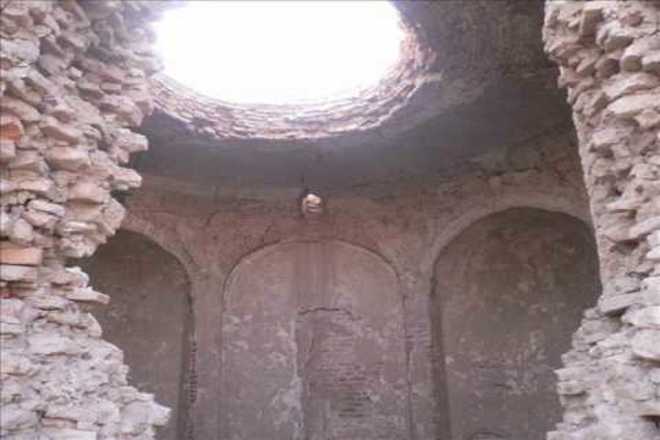PRAHALADPURI TEMPLE – The Place of Birth of Holi Festival
PRAHALADPURI temple, located in Multan, Pakistan was an ancient temple, stated to be 2800 years old. It is named after Prahalad and is dedicated to Lord Narasimha. It is said that the original Aditya (Sun) temple was built by Samba, son of Krishna, to recover from the symptoms of his leprosy 5000 years ago.
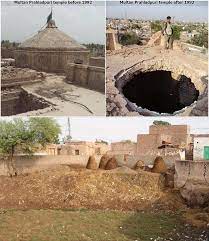
One of the holiest and oldest Hindu Shrines is at its eleventh hour after its destruction in 1992 by a fanatical mob of radical Islamic people in retaliation for the demolition of Babri Musjid in Ayodhya, India.
What is Holi? Why it is being celebrated?
Holi is the festival of colors for Hindus. People used to put colors on each other as part of the tradition. Holi festival is one of the biggest celebrations for all Hindus around the world.
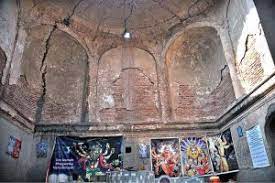
Even people would be aware of why it is being celebrated, its origination, and why it is so auspicious. But people might not be so knowledgeable of its place of birth or temple of birth and how its present state.
The Description of the Holi Festival in Hindu Mythology
Hiranyakashipu is one of the deadliest and most furious personalities in the history of Hindu mythology. His son Prahalad happened to be an ardent devotee of Lord Vishnu. Hiranyakashipu was extremely critical of this because he had deep hatred towards Lord Vishnu.
Seeing his son becoming a devotee of Vishnu, he tried to punish Prahalad through various means like poisoning, putting him under the feet of mighty elephants so that they would smash him, imprisoning him with poisonous snakes, and throwing him from high mountains. But due to the blessing of Lord Vishnu, Prahalad remained unaffected. Finally, he forced young Prahalad to sit in the lap of Holika, his paternal aunt, and they were set on fire.
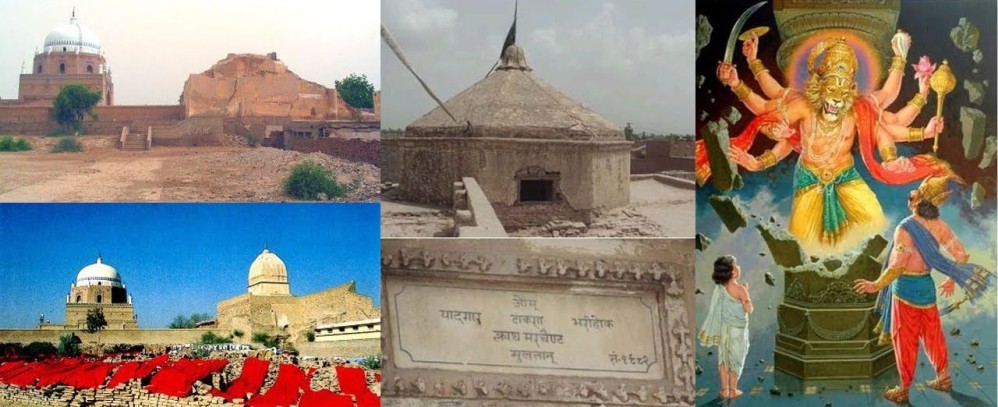
When the fire started consuming Holika, Lord Vishnu appeared in the form of Narasimha- a half-man and half-lion avatar (incarnation and cut Hiranyakashipu into pieces with his sharp nails and saved Prahalad. The festival of Holi celebrates this incident. This is the temple where Lord Narasimha killed cruel Hiranyakashipu, the king of Multan (Kashya-papura).
History of Prahaladpuri Temple
Though the original Sun temple at Multan was built by Samba according to Hindu mythology, it finds its roots in the time of 515 BC because Greek Admiral Skylax mentioned when he had passed through this place during that period. The ancient name of Multan as described in Hindu mythological books as “Kashyapapura” is also mentioned by the great Greek historian Herodotus.
The great Chinese scholar and traveler Hiuan Tsang is believed to have visited the Multan Sun Temple in 641 AD and given a brief description of the temple. According to Hiuan Tsang, the idol of the Sun God was made of pure gold, and the eyes of the idol were of large red rubies.

The doors, pillars, and top (shikhara) were plastered with gold, silver, and gems. A large number of Hindus used to worship the Sun God here and the presence of several Devadasis (Female Dancers) as referred to by Hiuan Tsang. Other noted travelers like Istakhari have also mentioned this.
Architecture of the Temple
The temple is on a high platform inside Multan Fort and happened to be a prominent landmark of Multan before 1992. The temple was comprised of the main hall, circumlocutory and skylights, and a large mandapa.
The central hall had a replica of an idol under a baldachin and there was a hotel (Dharamshala) adjacent to the temple. It is said that the original structure was columnar and both the roof and the columns (pillars) supporting it were made of pure gold. But the entire building was collapsed for some reason and a new temple was built at the site.
Islamic Rule in Multan
Umayyad Caliphate, under the leadership of Muhammad bin Qasim, took over the control of Multan in the 8th Century AD. But then Multan rulers are said to have protected it from any destruction and to keep Hindu invaders away from Multan by threatening its destruction.
Multan rulers are said to be earning huge sums of tax revenues from pilgrims. Hindu pilgrims used to offer gold, ornaments, and other valuables to the items and stones to the idol.
Destruction of Temple
In the mid-900s, Multan came under the rule of the Ismaili Shias, under the leader Jalam bin Shayban, a proselytizing Da’i of the Qarmatian sect. The dynasty of Ismaili rulers of Multan deliberately started the destruction of the temple in the late 10th century and built an Ismaili congregational mosque at the top of the site destroying the city’s old Sunni congregational mosque.
Later, in the 11th century the Ismaili mosque, built over the Sun Temple’s ruins was destroyed by Mahmud of Ghazni. The original name of the Multan was taken from the Sanskrit name Mulasthana. The noted Iranian scholar Al-Biruni visited this temple in the 10th century and gave a beaming description of the temple, though it was already in ruin by then.
Destruction of the Temple in the 19th Century by Muslim Invaders
The Prahladapuri temple was destroyed by Muslim invaders who suffered huge material losses and were reduced to a die-state by the 19th century. It is situated inside the Fort of Multan. The report suggests that the temple was once rebuilt in 1810 when the area was under the rule of Sikhs. But by 1831 it was again found deserted and had no roof.
When the British laid siege to Multan Fort in 1849, one shell fired by the British army blasted the gunpowder store inside the fort causing heavy damage to the fort, fortunately, the Prahaladpuri temple escaped unhurt.
The present Prahaladpuri temple was first built in 1861 by one Mahant Bawl Ram Das from public donation. In 1881, violent clashes erupted between Hindus and Muslims about the renovation of the temple over the height of the temple and dome of the adjacent mausoleum and led to the destruction of 2 mosques and 22 temples. Then British administration of Punjab did nothing to control this riot which put the Prahladapuri temple in ruin.
However, the temple was soon rebuilt by the then-affluent Hindu community of Multan and was managed by the community and regulated Mahant of Prahladpuri temple.
After the partition and formation of Pakistan, the majority of Hindus migrated to India, and the temple was managed by a minority Hindus of in the city. The original idols of Lord Narasimha were taken by Baba Narayan Das Batra from Multan at the time of independence in 1947 and placed in a temple at Haridwar.
Present State of the Temple
You can watch the video and pictures of this Prahaladpuri temple and it is enough to bleed your heart. We in India have maintained minority shrines so well, the Taj Mahal is the biggest example of that, and see how our Hindu shrines are being behaved in Pakistan.
The temple came under the vicious attack of a violent Muslim mob in 1992 as a reaction to the demolition of Babri Musjid in India. In 2006, during Urs, the government of Pakistan ordered the construction of facilities for Wuzu, and in 2008 facilities for Langar on the premises of the temple.
When these actions were protested by some NGOs according to the Constitution of Pakistan, no Muslim construction can be done within the religious premises of others. The matter is still pending in court. Irrespective of many peaceful protests by minority Hindu organizations, NGOs, and social activists for the restoration of the old temple, the Government of Pakistan seems to be in no mood to do that.
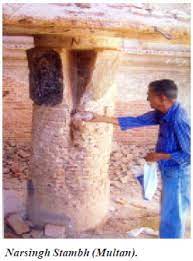
After the creation of Pakistan, the communal violence of the 1940s and the subsequent mass migrations have put Hindus in a very small percentage of the total population of Pakistan. Since Pakistan declared it as an Islamic nation and has strictly pursued Islamic course in its political and social life since the 1980s,
Hindus as a minority in Pakistan are exposed to considerably fewer privileges, rights, and protections in comparison to minorities in India. Therefore, the people of India and the international community must come forward to put pressure on the Pakistan establishment to the restoration of this large cultural heritage.






